Girl with a Flute
c. 1665–1670Oil on panel
20 x 17.8 cm. (7 7/8 x 7 in.)
National Gallery of Art, Washington D.C.
EV SURVEY
Is the Girl with a Flute an authentic work by Vermeer?

"National Gallery of Art Confirms One of Its Vermeers Is not by Vermeer" - CODART
October 10, 2022 <https://www.theguardian.com/artanddesign/2023/jan/02/vermeer-row-authenticity-girl-with-a-flute-painting>
The National Gallery of Art in Washington announced groundbreaking new findings about Johannes Vermeer which led an interdisciplinary team of curators, conservators, and scientists to determine that the painting Girl with a Flute was made by an associate of Vermeer—not by the Dutch artist himself, as was previously believed (see: <https://jhna.org/articles/vermeers-studio-and-the-girl-with-a-flute/>
Following decades of study, the National Gallery team concluded that Girl with a Flute is not, in fact, by Johannes Vermeer. Instead, they believe, the painting was made by an associate of Vermeer—someone who understood the Dutch artist’s process and materials but was unable to completely master them. Exactly who that person might be remains to be determined, but the implication that Vermeer worked closely with other artists is significant, as it revises the long-held belief that Vermeer worked in isolation. The mystery artist could have been a pupil or apprentice, an amateur who paid Vermeer for lessons, a freelance painter hired on a project-by-project basis, or even a member of Vermeer’s family.
The team compared Girl with a Flute (fig. 1) to Vermeer’s Girl with the Red Hat (fig. 2). Both are small paintings previously hypothesized to be a pair due to similarities in subject, size, and use of a wood panel support—unusual for Vermeer. However, the paint application in Girl with a Flute is very different from Girl with the Red Hat. Not only does it lack the precision for which Vermeer is known, but the artist seems not to have had Vermeer’s control: the brushwork is awkward, and the pigments used in the final paint are coarsely ground, giving the surface an almost granular character. Vermeer ground his pigments coarsely for his underpaint and more finely for the final paint layers to achieve their delicate surfaces. The artist of Girl with a Flute inexplicably reversed this order. Despite the different handling, microscopic pigment analysis showed that both compositions used the same pigments, even including green earth shadows of the face—an idiosyncratic feature characteristic of Vermeer’s paintings. Taken together, these findings clearly show that, although Vermeer did not paint Girl with a Flute, this artist was intimately familiar with Vermeer’s unique working methods.
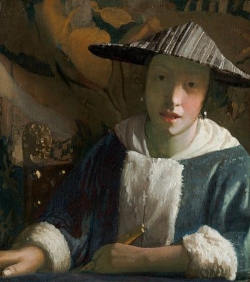 Fig. 1 Girl with a Flute
Fig. 1 Girl with a Flute Johannes Vermeer
c. 1665–1670
Oil on panel, 20 x 17.8 cm.
National Gallery of Art, Washington D.C.
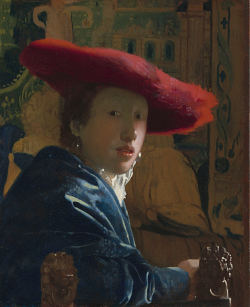
Johannes Vermeer
c. 1665–1667
Oil on panel, 23.2 x 18.1 cm.
National Gallery of Art, Washington, D.C.
Research also led curators to determine that Girl with the Red Hat was made at a turning point in the artist’s career. The painting shows Vermeer experimenting with new techniques—vivid colors, a bolder manner of applying the paint—that presage paintings produced in the final phase of his career. As a result, they believe the painting should be dated slightly later, to circa 1669 (the work was previously dated to circa 1666/1667).
Many of the findings expand our understanding of the earliest stages of Vermeer’s painting process. One of the most exciting discoveries, made by comparing the results of different scientific imaging techniques with microscopic analysis, was the realization that Vermeer began his paintings with broad strokes in a quickly applied underpaint that established a robust foundation for his characteristically smooth and refined surface paint.
Researchers took advantage of the museum’s COVID-related closures in 2020/2021 to examine the museum’s four paintings by and attributed to Johannes Vermeer. The research results are explored in the exhibition Vermeer’s Secrets (on view through 8 January 2023). The exhibition outlines some of the most exciting findings along with scientific images of the paintings, and even one of the specialized technical instruments used to conduct the imaging.
Research team
The research team consists of Marjorie E. Wieseman, curator and head of the department of northern European paintings; Alexandra Libby, associate curator, department of northern European paintings; Dina Anchin, associate paintings conservator; E. Melanie Gifford, retired research conservator of painting technology; Lisha Deming Glinsman, retired conservation scientist; Kathryn A. Dooley, imaging scientist; and John K. Delaney, senior imaging scientist.
Studio, Amateur, or Vermeer after all?
Given all the similarities between Girl with a Flute (fig. 1)
and Girl with a Red Hat (fig. 2), it is no surprise that the two paintings have been repeatedly discussed as paired or pendant portraits in art history literature and that the issue of their attribution has also been approached in tandem by multiple authors. For example, some scholars have at various times in the past placed the tronies outside Vermeer’s oeuvre while others have subsequently placed them back in. It has even been suggested that Girl with a Flute was begun by Vermeer and then completed by another painter after his death, with Jan Coelenbier of Haarlem, who bought several paintings from Catharina Bolnes in 1676, named as a candidate. This yo-yo exercise between attribution and exclusion shows how unique the two works are and how difficult they are to place based on our knowledge of Vermeer’s oeuvre and practice.
In its recent investigation, the research team of the National Gallery of Art applied the newest technology to identify the materials used and the painting method. This revealed surprising aspects in Girl with a Flute, which differ from the technical data on Vermeer at our disposal until now. They observe various deviations, such as an unusually coarse and brushmarked texture in the upper ground layer, an underpaint in the blue jacket that does not serve to model the shape, more simply modelled highlights in the clothing, and the use of coarsely ground pigments in the upper paint layers. They note that the greenish shadow was applied more roughly and thickly than was usual for Vermeer. Furthermore, they point out noticeable drying cracks due to shrinking that affect the appearance of the surface and deduce, among other things, a sloppy and inexpert finish from the presence of an excessive number of broken bristles in the paint. Other perceived defects include an unusual green highlight that was placed in the corner of the girl’s mouth, the holes of the flute that are not in a straight line and the striped pattern of the conical hat that shows mistakes.
Based on these findings, the researchers conclude that Vermeer was not involved in the creation of the painting; instead, the tronie was made by a contemporary who had a close relationship with him and a thorough knowledge of his work methods. They observe that the painter responsible was not only inspired by Vermeer’s style but also imitated his unique approach. The painting processes of Girl with a Red Hat and Girl with a Flute in fact so resemble each other that they can imagine that the maker of the latter painting saw Vermeer at work. A crucial factor is that the painter, in the view of the American research team, lacked the skill necessary to reproduce Vermeer’s masterful brushwork and subtle effects; in short, he or she was "an artist who understood the process, but was not able to achieve its effect." In addition they see a clumsy composition and an untrained treatment of paint by a painter who had not mastered his or her craft.
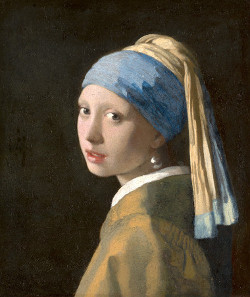
Johannes Vermeer
c. 1665–1667
Oil on canvas, 46.5 x 40 cm.
Mauritshuis, The Hague
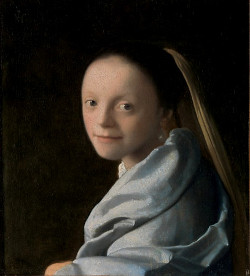 Fig. 4 Study of a Young Woman
Fig. 4 Study of a Young WomanJohannes Vermeer
c. 1665–1674
Oil on canvas, 44.5 x 40 cm.
Metropolitan Museum of Art, New York
What stands out is that in the details Girl with a Red Hat surpasses Girl with a Flute artistically. For example, the reflected sunlight on the lion’s-head finial of the chair in the former painting is more stylized here in comparison to the second work. The softness of her face is also achieved with more conviction, although it differs from the extremely fine modelling in Girl with a Pearl Earring (fig. 3) and Girl with a Veil (fig. 4). When we zoom out to Vermeer’s known oeuvre we notice that he used a similar, somewhat angular modelling of the face in The Lacemaker (fig. 5) and Mistress and Maid as well. In describing Girl with a Flute, for specific details like the arm and the hand, authors sometimes choose words like "weak’ and ‘awkward." However, several of his paintings show a certain difficulty with or a lack of interest in the depiction of hands. The bent wrist of the girl with a veil (fig. 6 ), for instance, raises questions, and even the main protagonist in The Art of Painting is depicted with a swollen hand that seems to lack joints (fig. 7). On the whole it must also be noted that the condition of Girl with a Flute is not as good as that of Girl with a Red Hat. The little painting has suffered more over the centuries, with the underlayers becoming exposed, details being lost from the top layers and the work being retouched in several places. This has consequences for the legibility of, among other things, the face, the hat, the white fur on the left sleeve and the right hand of the girl.
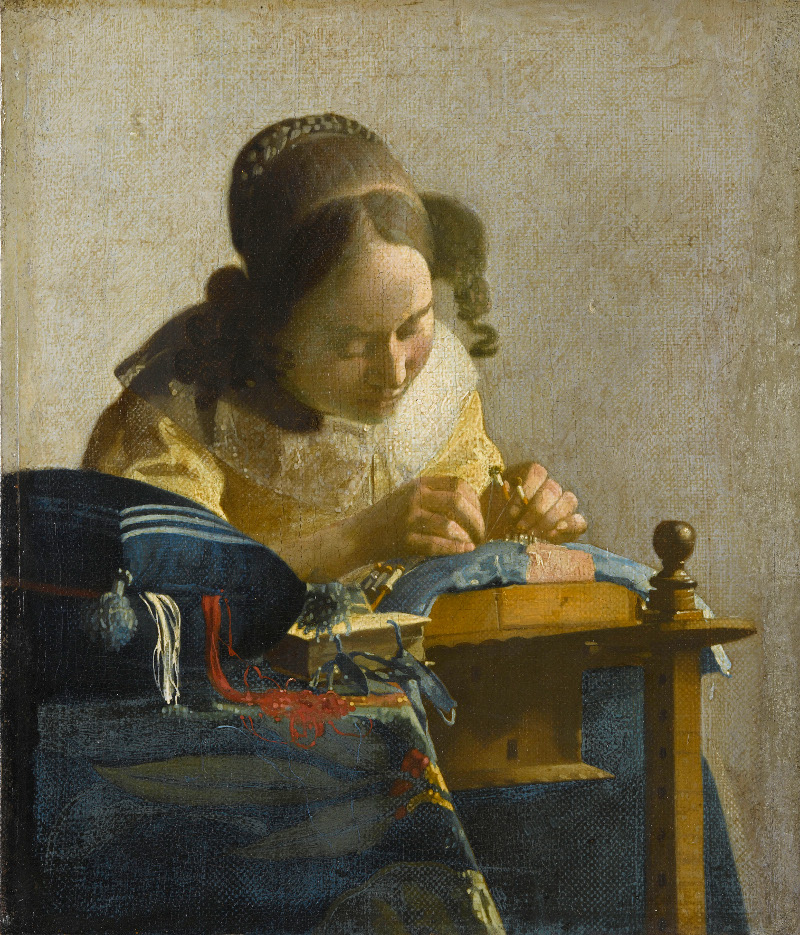
Johannes Vermeer
c. 1669–1671
Oil on canvas on panel, 24.5 x 21 cm.
Musée du Louvre, Paris

Johannes Vermeer
c. 1665–1674
Oil on canvas, 44.5 x 40 cm.
Metropolitan Museum of Art, New York

Johannes Vermeer\
c. 1662–1668
Oil on canvas, 120 x 100 cm.
Kunsthistorisches Museum, Vienna
While a number of their insights can be disputed, the analysis of the research team does lead to new research questions on the work of Vermeer and opens new windows in thinking. Are we looking here at a trekschuit that was inspired by an original by Vermeer, and is Girl with a Flute the first painting that can be identified as a studio work? Are we dealing with a copy, or instead with a replica by his own hand, or even a "principal" by Vermeer himself? Two important questions are how an inexperienced assistant or amateur was able to achieve this innovative composition and why Vermeer, as an instructor or mentor, did not alert the painter in question to the ‘mistakes’ he or she was making. We also find several of the apparent anomalies in Girl with a Flute, such as the coarse upper layer showing visible brushstrokes and the thickly applied green earth around the face, in The Love Letter. An excessive number of broken bristles have also been found in Girl with a Pearl Earring and The Milkmaid. In addition, a number of pentimenti are visible, conceptual steps in the painting process in which the artist corrected himself, as we see here in the fur trimmings placed over the original V-neck of the jacket, the left shoulder that was lowered and the finger that was added onto the flute. This does not argue in favour of a copy or replica.
What is beyond dispute is that Girl with a Flute and Girl with a Red Hat cannot be better compared with any other known work from the seventeenth century than with each other. Both paintings belong to the most idiosyncratic works to come out of Vermeer’s painting room in the third quarter of the seventeenth century. Through their form and presumed use for study they occupy an entirely unique position within his oeuvre, but they do show similarities to his other work. From a broad and inclusive view of his oeuvre we are therefore staying, in this publication, with the attribution of Girl with a Flute to Vermeer, and we presume that the painting was made primarily for study and preceded the other three tronie.
Exceptional Skill
In the aforementioned Dissius auction of 1696, the qualification "of exceptional skill" was added to Number 38, "A Tronie in Antique Garments."This painting was sold for 36 guilders. Under Numbers 39 and 40, "another ditto by Vermeer" and ‘an equal of the same’ were listed. Each of these two tronies changed hands for 17 guilders, less than half the previously cited sum. Based on the distinction described in this text between Girl with a Pearl Earring and Girl with a Veil as perfected, refined tronies for the market, on the one hand, and Girl with a Flute and Girl with a Red Hat as small, experimental works used primarily for study, on the other, we may assume that the auction reflects the same distinction. It is possible that one large and two smaller tronies by Vermeer found their way into the collection of Van Ruijven and Dissius. It is quite likely that this listing concerned Girl with a Flute, Girl with a Red Hat, Girl with a Pearl Earring or Girl with a Veil, but this will probably never be established with certainty. That each of these four tronies was painted with "exceptional skill," however, is beyond doubt.

Jennifer Rankin
"When is a Vermeer not a Vermeer? Reputations on the line over authenticity of artwork" - The GuardianJanuary 2, 2022 <https://www.theguardian.com/artanddesign/2023/jan/02/vermeer-row-authenticity-girl-with-a-flute-painting>
Johannes Vermeer of Delft left behind fewer than 50 paintings when he died aged 43 in 1675. Those that survived have beguiled art lovers for more than a century: intimate domestic scenes, such as a girl reading a letter at an open window, or a maidservant absorbed in pouring milk, bathed in soft, gentle light. As Vermeer’s output was so small, it is an event when a painting is declared to be by his hand. But there are few precedents for a recent tussle over the artist. One painting has been declared definitively "a Vermeer" by one museum, while another has downgraded it.
In October, the National Gallery of Art in Washington DC announced the results of painstaking research into a work in its collection, long credited to Vermeer (see: <https://jhna.org/articles/vermeers-studio-and-the-girl-with-a-flute/>. Girl with a Flute was not by Vermeer, but an associate, it said. Less than a month later the Rijksmuseum in Amsterdam, which is borrowing that painting for a major new Vermeer exhibition in 2023, reached the opposite conclusion about the same work. It was "crystal clear," the Rijksmuseum said, Girl with a Flute was a Vermeer.
Painted on a small wooden panel, Girl with a Flute shows a woman wearing a boat-shaped hat and fur-trimmed jacket seated by a patterned tapestry, holding an instrument. While it has similarities to another work attributed to Vermeer, experts have long had doubts.
"I never considered it as satisfying as other paintings by Vermeer," Marjorie E Wieseman, the head of the department of northern European paintings at Washington’s National Gallery, told the Guardian.
"What makes a Vermeer a Vermeer is his really uncanny ability to engage the viewer, to evoke a mood, a sensation, a presence that somehow transcends time," she said. The women in his paintings, she said, have "a deliberate reserve…rather than extending something out to you, the viewer, they’re pulling you in."
Girl with a Flute, quite simply, does not, according to the Washington team. But it was only when Covid lockdowns forced the museum’s closure that the team had an opportunity to put their Vermeer collection under the microscope, using pioneering imaging technologies also used to map minerals on the moon and Mars.
If Girl with a Flute is not by Vermeer, another question remains open: the identity of the artist in his studio. The National Gallery in Washington has suggested several candidates. Perhaps the painter was an apprentice, or a wealthy amateur taking lessons who helped a hard-up Vermeer pay his bills. The Washington team is less convinced by the thesis that the artist was Vermeer’s eldest child, Maria. "We simply cannot know who did paint the work, or under what circumstances," they concluded.
Sluijter thought it was plausible that Vermeer’s daughter was responsible for Girl with a Flute. "It’s not that eccentric, it is a possibility. We know of other daughters working in their father’s studio in the 17th century," he said. "Often they married and then stopped painting, so they didn’t go on to become independent artists."
With scant documents in the archives, the identity of the possible artist in Vermeer’s studio remains a mystery to unravel.
Young Girl with a Flute is a fascinating and problematic painting, whose place within Vermeer's oeuvre, and even century of origin, have long been disputed. The panel support, the style of the costume, and the quality of execution all raise questions about the attribution. Although the discolored varnish and old repaint that distorted the image were removed during the painting's restoration in 1995, even now extensive abrasion of the paint surface hinders a conclusive assessment of artistic quality. The blue glaze that once covered the back or the chair, for example, has now mostly disappeared, leaving visible only the reddish-brown underpaint. Nevertheless, the restoration and related technical examinations have provided a fuller understanding of both the complex compositional alterations and the sequence of paint layers that comprise this image, information essential for any informed judgment of attribution. The Young Girl with a Flute is the only painting on panel exhibited here, other than The Girl with the Red Hat. Owing also to their similarities in scale and subject matter, scholars frequently cited these works as pendants. Indeed, both girls look expectantly toward the viewer with alert eyes and half-open mouths. Each wears an exotic hat, sits before a tapestry in a chair with lion finials, and leans on one arm. Light enters from the left in both compositions, striking the left cheek, nose, and chin of both figures. A thin green glaze pulled over the flesh tone, moreover, indicates the shaded portions of both faces. Finally, colored highlights accent each mouth, turquoise in The Young Girl with a Flute and pink in The Girl with the Red Hat (fig. 8).
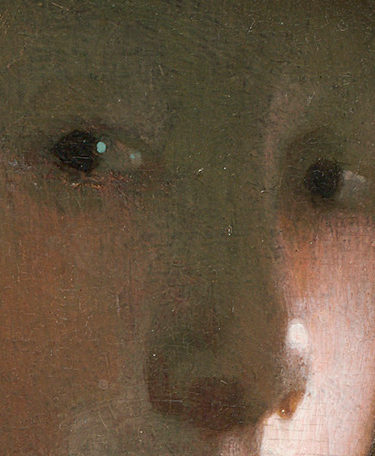 Fig. 8
Fig. 8 c. 1665–1667
Oil on panel
23.2 x 18.1 cm. (9 1/8 x 7 1/8 in.)
National Gallery of Art, Washington, D.C.
Despite these similarities, slight differences in both the size of the panels and the compositional arrangement of the figures indicate that the paintings are not companion pieces. Differences in artistic quality prove even more significant. In Young Girl with a Flute, the flesh tones of the face are modulated with a better degree of refinement. Transitions between the shadow of the eye and the sunlit cheek, the shaded and unshaded portions or the chin, and the areas between the nose and mouth, appear abrupt (fig. 9). Unusually thick impasto defines the girl's thumbnail and ill-proportioned right hand, and the flute in her left hand is inaccurately rendered.
A comparison of the lion-head finials in the two paintings (fig. 10 & 11) also illustrates the relatively unrefined brushwork of the Young Girl with a Flute. While Vermeer modeled the right finial in the Girl with the Red Hat with subtle variations in the weight and thickness of brushstrokes, those in the Young Girl with a Flute less successfully create a sense of form and volume. In addition, the diffused, yellow highlights enliven the blue jackets in a different manner. In the Girl with the Red Hat Vermeer first highlighted the blue robe with light blue strokes and then applied short dabs of thin lead-tin yellow paint. He then painted the ridges of the highlighted folds with strokes of opaque lead-tin yellow. The jacket of the Young Girl with a Flute is painted in a similar technique, but the colors appear less fresh and the strokes less fluid.
Many shared characteristics between these paintings, however, complicate efforts to attribute Young Girl with a Flute. Moreover, a judgment based on a single comparison is always ill-advised, particularly when so little is known about an artist's oeuvre. Indeed, stylistic connections exist between Young Girl with a Flute and other Vermeer paintings. The softly modeled yellow highlights on the blue jacket, for example, resemble those on the blue edging of the yellow material hanging from the turban in Girl with a Pearl Earring. By the end of the 1660s and early 1670s, moreover, Vermeer modeled forms with more, abrupt transitions, similar to those that define the girl's face. Finally, the blocky character of the brushstrokes defining the finial (fig. 4) compares well to the abstract modeling of the gold picture frame in, for example, A Lady Seated at a Virginal.
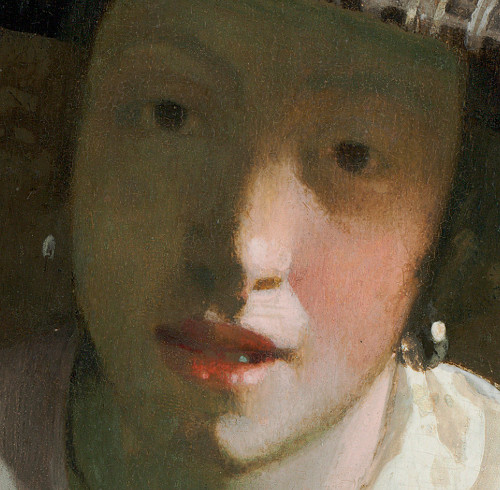
Johannes Vermeer
c. 1665–1670
Oil on panel, 20 x 17.8 cm.
National Gallery of Art, Washington D.C.
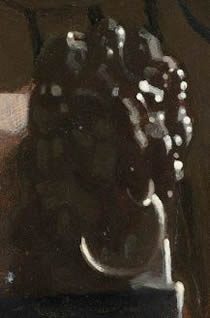 Fig. 10
Fig. 10 Johannes Vermeer
c. 1665–1667
Oil on panel, 23.2 x 18.1 cm.
National Gallery of Art, Washington, D.C.
Johannes Vermeer
c. 1665–1670
The attribution of this small panel painting is even more controversial than Girl with a Red Hat. Although the wind instrument in the girl's left hand has usually been called a flute, it is not very clearly depicted and could be a recorder. This poor representation of a musical instrument is rare in the work of Vermeer.
The girl's hat is unusual (fig. 12); its shape is similar to that of a Chinese coolie hat, which would have been considered an exotic curia in the Netherlands at the time. However, it is not made of straw and the parallel stripes would have been impossible to produce on a conical shape. Although the hat has been cited as evidence that the painting is a fake, it is strange that a forger should have invented such bizarre headwear.
Scientific examination of the picture suggests that it does indeed date from Vermeer's time. A dendrochronology analysis of the oak panel, based on an examination of tree rings, shows that the tree was felled in the early 1650s and, since wood needs to be seasoned before use, this is quite consistent with a painting dating from. 1665. This refutes the suggestion that it is a nineteenth-century fake, unless the forger had managed to find a panel of just the right period.
It has been suggested that the picture could be the work of one of Vermeer's children, although there is no evidence that any of them painted. Another possibility is that the painting might have been started by Vermeer and completed after his death by another artist, such as the Haarlem painter Jan Coelenbier (active from 1632), who bought pictures from Catharina in 1676.
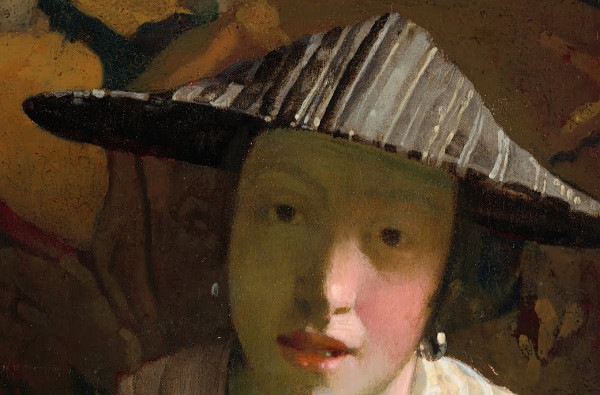
Johannes Vermeer
c. 1665–1670
Oil on panel, 20 x 17.8 cm.
National Gallery of Ar, Washington D.C.
Girl with a Flute was discovered in a private collection in Brussels by Abraham Bredius, who exhibited it at the Mauritshuis in 1906. It was bought by the American collector Joseph Widener in the 1920s and given to the National Gallery of Art in Washington in 1942. There still remains considerable disagreement about the attribution. Blankert rejects it completely and Wheelock believes that the painting should be "attributed" to Vermeer. For the moment "circle" of Vermeer may welt be a fairer assessment, in that it is probably not from the master's hand, but by another artist of the period working in his style.


